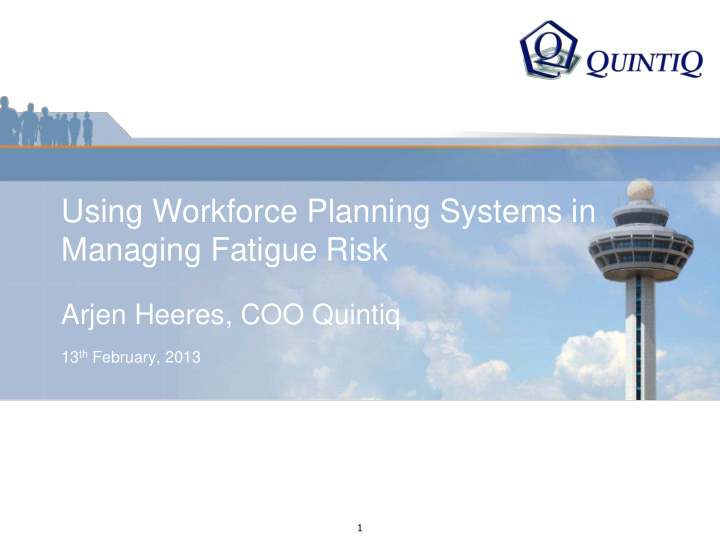



Using Workforce Planning Systems in Managing Fatigue Risk Arjen Heeres, COO Quintiq 13 th February, 2013 1
Agenda Agenda Introduction and Quintiq company What is FRMS and why is it important? Fatigue issues and how to manage them Quintiq software solution Q&A 2
Company Profile Quintiq is a leading software company focused on providing Focus Advanced Planning and Optimization software Offices around the world Facts 700 employees HQ: Philadelphia & ‘s -Hertogenbosch (Netherlands) ANSP’s FAA Logistics Broadcasting Rail 3
Agenda Agenda Introduction and Quintiq company What is FRMS? Fatigue issues and how to manage them Quintiq software solution Q&A 4
FRMS Fatique A physiological state of reduced mental or physical performance capability resulting from sleep loss or extended wakefulness, circadian phase, or workload (mental and/or physical activity) that can impair a controller’s alertness and ability to safely perform safety related duties FRMS (Fatique Risk Management System) A data-driven means of continuously monitoring and managing fatigue- related safety risks, based upon scientific principles and knowledge as well as operational experience that aims to ensure relevant personnel are performing at adequate levels of alertness. An FRMS aims to ensure that ATCO’s are sufficiently alert so they can operate to a satisfactory level of performance Source: ICAO, 2011 5
FRMS and Scheduling + Task Assignment Shift Planning FRMS Task Assignment • Minimum rest hours • Rotational shifts with progressively later start times MDDEN vs EEDDN (2-2-1) • Complexity of tasks • Rest between tasks 6
Age Circadian Rhytm Shift Swapping Forecasted Traffic Rotation patterns, Shift Planning Volume quickturns Scheduled Overtime Minimal hours between shifts On-the-Job-Training Trainees < –> CPC’s Sources: Air Traffic Control: Potential Fatique Factors , FAA, June 29, 2009 - Fatigue Management for the Australian Aviation Industry, Australian Civil Aviation Safety Authority, May 2012 - 7
Disruptions; adverse Ad Hoc Overtime weather, runway closed Task Assignment Workload balancing Position Rotation Time on Position Complexity of position Sources: Air Traffic Control: Potential Fatique Factors , FAA, June 29, 2009 - Fatigue Management for the Australian Aviation Industry, Australian Civil Aviation Safety Authority, May 2012 - 8
Fatique and Work Schedules Source: Australian Independent Transport Safety Regulator 9
Agenda Agenda Introduction and Quintiq company What is FRMS? Fatigue issues and how to manage them Quintiq software solution Q&A 10
Staged approach 1. Capture Rules 1. Define Goals 1. Define Rules in Supporting System 12
Agenda Agenda Introduction What is FRMS? Fatigue issues and how to manage them Quintiq software solution Q&A 13
Process Overview 1. Translate flight traffic forecasts into headcount 2. Create roster Aggregation Step 1 3. Assign tasks/positions and breaks Sector N Operational sector Flight information configuration Sector S1 14
ALL rules and constraints must be taken into account Individual preferences Leave planning Working time directives Tower specific circumstances Rules to reduce stress Compensatory time-off Mix of skills Meal premiums Rules for shift cycles Short notice shift change premiums Shift bidding policies Overtime requirements Detailed training requirements … Demand scenarios … Overtime volunteering policies Shift exchanging rules Forbidding shifts Robustness requirements Requesting / approving leave Supervisor team preferences Additional project work 15
Planning = Balancing between goals Fati tiqu que Effici Ef ficien ency FRMS Shfit Planning FRMS Task Assignment Decrease need for overtime Decrease overcapacity Management reporting ATCO CO Pr Pref efer eren ence ces Individual preferences Prevent work overload Custome Customer Reduce stress and fatigue Compliance with labor and union l Sati Sa tisf sfac acti tion on Adapt to traffic volume Accommodate disturbances 16
Planning = balancing between goals Fati tiqu que Ef Effici ficien ency FRMS Shfit Planning FRMS Task Assignment Decrease need for overtime Decrease overcapacity Management reporting ATCO CO Pref Pr efer eren ence ces Individual preferences Custome Customer Prevent work overload Reduce stress and fatigue Sati Sa tisf sfac acti tion on Compliance with labor and union laws Adapt to traffic volume Accommodate disturbances 17
Planning = balancing between goals Fati tique que Ef Effici ficien ency FRMS Shfit Planning FRMS Task Assignment Decrease need for overtime Decrease overcapacity Management reporting ATCO CO Pref Pr efer eren ence ces Individual preferences Custome Customer Prevent work overload Reduce stress and fatigue Sati Sa tisf sfac acti tion on Compliance with labor and union laws Adapt to traffic volume Accommodate disturbances 18
Planning = balancing between goals RULES, CONSTRAINTS AND GOALS 19
Fati tique que Effici Ef ficien ency FRMS Shfit Planning FRMS Task Assignment Decrease need for overtime Decrease overcapacity Management reporting ATCO CO Pr Pref efer eren ence ces Individual preferences Customer Custome Prevent work overload Reduce stress and fatigue Sa Sati tisf sfac acti tion on Compliance with labor and union l Adapt to traffic volume Accommodate disturbances 20
How to start? Defining Goals and Rules System First Version More advanced connected to all containing basic system users, containing fatique rules containing individual complex rules dashboards Semi automatic Automatic Alerting Full automatic Optimization functions optimization 21
Questions? 22
Recommend
More recommend